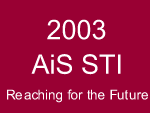
Adventures in SuperComputing - Summer Teacher Institute
Dreamweaver Fundamentals
Development Phase
Now the learner is ready to drive toward putting their ideas into a format that can lead to a demonstration of the learning. Again, it is important that you begin this phase by revisiting the planning stage and identifying the areas that need to be worked on in order to complete the task. This is coupled with reviewing the research phase in order to discover ways to put your ideas into reality.
Dreamweaver MX will be a valuable tool to revisit in this stage, as you now build an interface for your Web pages. The skills associated with Dreamweaver's design view are akin to word-processing software, and this may be the one tool with which you have the most experience. It is important to remember that although Dreamweaver is an Editor that provides a WYSIWYG (What You See Is What You Get) look and feel, the most important thing to remember is that Dreamweaver writes code, which includes HTML, CSS and JavaScript.
Now, the technology tools are framed in another context for learning and can be integrated for the development phase. Copying the Internet address (URLs) in the browser and pasting into the document is one example of this type of integration. Also, information from the Internet can be synthesized into a document that can become the research base for the final product. Of course, as a teacher you should discuss the topic of plagiarism, and this is best avoided by requiring a unique student task that will frame the research. In the example of the Adventures in SuperComputing Challenge, students will have a set of guidelines, including references of sources, yet the basic task should in no way be considered rote. To foster critical thinking is to put forth unique situations for students to study and to reinforce their ideas with citations of factual information found in research. It should foster analysis, evaluation, and synthesis of information, all higher-order thinking skills.
The big areas we will explore here in Dreamweaver MX are links and graphics.
See Macromedia Dreamweaver Reference Text - Chapters 5 and 6
